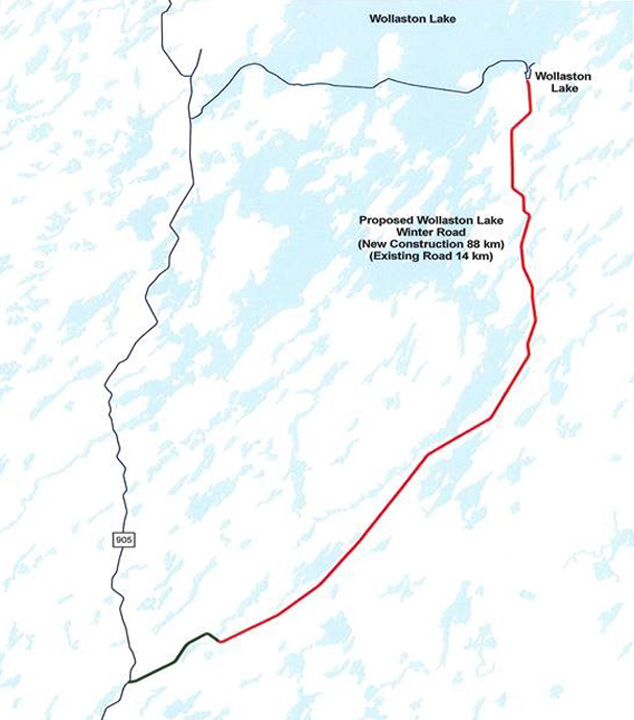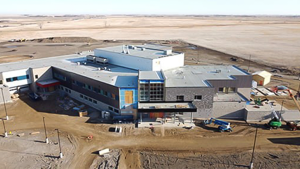Crews have started laying the groundwork for a packed snow winter road to be built in northeastern Saskatchewan that will connect the remote community of Wollaston Lake to the province’s existing network.
The 88-kilometre road will run from just east of Highway 905 to the isolated area of approximately 1,300 people. Fourteen kilometres of the road was started in 2010 but stalled with only 14 kilometres being laid.
Work on the $7 million snow road could be the first phase of a project that would eventually result in an all-season road into the area. The Saskatchewan government has awarded a contract for a study that will assist it in making a business case to the federal government to fund future phases of the project.

Presently, the community gets food, fuel and building supplies transported by barge across Wollaston Lake in the summer and via a 42-kilometre ice road in the winter which is often not opened until February. The snow road would increase access to the community by one or two more months each year.
“It’s pretty challenging to get it open,” says Blair Wagar, assistant deputy minister for the policy, planning and regulation division of the Ministry of Highways and Infrastructure. “It typically doesn’t open until February and we’re pretty lucky if it lasts until the end of March, so it’s a pretty short period of time.
“This road would be much safer. You’re not dealing with actually having to drive over the ice. There have been instances where vehicles have gone through the ice, so at the end of the day we’re trying to connect part of our province and that population to a much safer and more reliable transportation system.”
The route for the winter road would generally run to the south and east of Wollaston Lake to the community. Crews are now clearing trees along the route for the road, doing grading work and removing embankments and a rock cliff.
“Right now, most of the work taking place is big heavy work,” says Wagar. “A lot of it is moving aggregate and cutting some of these hills down so that they can be passable.
“It’s part of the Canadian Shield, so it’s a very different construction environment. They’re having to knock some of that stuff down. That’s what’s taking place. They’re getting ready for next year when hopefully we’ll be able to build the combination of ice road over some of the crossings and the frozen snow road.”
Typically, roads are built sequentially, in that the roadbed is put down and the project moves along linearly. In this case, however, crews are working at “hot spots” along the length of the route at the same time.
Crews may cut down a hill in one area and use the dirt as fill in other areas along the route, says Wagar. They are also removing trees, stumps and other obstructions along the route so that when winter arrives and the ground freezes, crews can clear the route and the packed snow can be driven on.
The work is challenging, notes Wagar, because the project is in a remote area.
“The fact that it’s pretty far in our provincial north poses a bit of a challenge in terms of getting equipment that’s needed into the location. That would probably be our toughest challenge compared to a lot of other places,” he says.
“The landscape is also rugged and it’s not necessarily flat land. You’re dealing with a combination of muskeg in the north and you’re dealing with a lot of water crossings. It’s fantastic landscape, especially if you love to fish. It’s fantastic, but for road construction it’s pretty challenging.”
Contractors doing the work must transport equipment to the site via the existing Highway 905 from the south, or across the ice road in the winter from the north.
Crews are presently trying to get as much work done as they can before summer sets in and the ground thaws.
Work on the route will be on hold during the summer months and resume in late fall or early winter. The government is hoping the road might be in use next winter.
David Horth, assistant director, communications and customer services at the Ministry of Highways and Infrastructure, says there are lengthy periods when Wollaston Lake is only accessible by air and a winter road will increase vehicle access by up to two months each year.
The second phase of the project would include building bridges and culverts along some waterways for an all-season road which would provide access for 10 months of the year.
“The province built the first 14 kilometres of the estimated 100-kilometre route from Highway 905,” he says. “It was always anticipated any additional work would involve support from our federal partners.”











Recent Comments
comments for this post are closed